Saving my own bacon
Only the particularly pig-headed will stick it out in the pork farming business
This article is taken from the February 2024 issue of The Critic. To get the full magazine why not subscribe? Right now we’re offering five issues for just £10.
My father loved his pigs. Not like he loved his dogs of course, but as a business. From the 1970s we were one of the larger breeders in the country, which at the time was a 6,000-sow herd.
This meant about 60,000 pigs. You could not be certain because the number changed with piglets being farrowed and — not so good for business — stock dying every hour. We sold 2,000 pigs a week. It is quite likely that you have eaten some of our bacon. In global terms that is small.
There are farms in the US with more stock than the UK’s entire herd. Despite impressive economies of scale, their animal welfare and husbandry standards will not be up to a standard that you would be comfortable with, to say the least.
I was never fond of the business. As a teenager I had to muck out pigsties and, having read about the farmer who killed his wife and then disposed of her by not feeding his herd — clothing remnants were found in a sty — I disliked those short-sighted, grunting, mud-barrels nipping the back of my wellies.
Artificially inseminating sows was also strangely humiliating. You followed an indifferent sow whilst squeezing semen into her from a bottle through a tube whilst she scratched herself against a wall. When it was over, after about ten minutes she often farted it out.
From 2000, profits could be had but they were patchy. We continually invested in the farms, for many years winning welfare awards, but the promised price premium was negligible. It was always cheaper for supermarkets to source from Europe.
Why? The EU had plenty of welfare and production regulation, but Whitehall managed to gild it, to the extent that if I had produced pork like the Danes there was a danger I would have been jailed for breaching welfare law. The NFU spent years making noises about this to no effect.
We spent millions on an innovative breeding unit, but it did not really reduce production costs. We spent almost as much on getting planning consent for a very large factory farm.
It stirred some controversy at the time. There are fewer campaigners more self-righteous and indignant than those whose sentimentality embraces animal rights. There was something like 250,000 letters and emails of objection to the planning authority, mostly from abroad.
We spent two years designing the piggery with Compassion in World Farming
An actor called Dominic West got himself pictured by the field gate saying how horrid the concept was. What he and the others were ignorant of was that this would have been the finest welfare-concerned piggery in the world.
We spent two years designing it with Compassion in World Farming, which had concluded that since it could not compulsorily force everyone to be vegetarian it might as well work with the meat industry to improve standards. However, so sensitive was it to criticism from its backers, that it declined to endorse the project.
We did not build it because I won the internal argument to exit the industry. It is, after all, a commodity business. No matter how good your product, you can’t command a premium. The buyer has all the margin power. The largest overhead was feed, most of which was grain, also a commodity.
The main characteristic of commodity production is that success or failure is not under your control. You can be an operational genius but if the price is against you, you lose money.
The opposite is also true: management duffers can preside over great returns on deployed capital if the price goes their way. The risk is then complacency because at some point the market turns and the duffers won’t be ready.
At the time we were also scrapping and recycling warships for the MoD — scrap also being a commodity. I pointed out that as a family with a private SME, we simply were not rich enough to withstand it if prices went downhill, as they were doing.
◆
January is, I find, the most expensive month. There are shoes to be paid for. Wife and daughters require fashionable labels that never go on sale, but worse are the bloody horses. Farriers now seem to charge £200 a set, a month.
I ask my darling wife, how many do you have? She equivocates and I think the truth is somewhere between 9 and 11. Unidentified items in the bagging area seem to be ponies and foals. I should go and count, but then an invoice will arrive from a livery yard I have never heard of.
Cousin Simon tells me that this is very normal, for he would never tell his wife how many racehorses he has. Seeing as the cost of a racehorse is about the same as putting a child through one of our esteemed public schools, I have learned not to complain too much about my wife’s hacking nags.
I once asked my father why he never owned racehorses when he loved to bet on them. “I prefer to limit my losses to gambling,” he replied. Well, that and commodity businesses.
Enjoying The Critic online? It's even better in print
Try five issues of Britain’s newest magazine for £10
Subscribe














